Exploring Cultural Representation of Female Sexuality and its Impact
VerifiedAdded on 2023/05/28
|8
|1463
|86
Essay
AI Summary
This essay examines the cultural representation of female sexuality, focusing on how societal institutions and patriarchal ideologies shape and prescribe women's roles and experiences. It analyzes the historical objectification of women in art and literature, highlighting the challenges women face in breaking stereotypes and asserting their agency. The study also considers the influence of social location, including class and race, on women's experiences and responses to gender roles and expectations. The essay concludes by noting the progress women have made in recent years toward achieving equality and challenging traditional portrayals, emphasizing the importance of literature and cultural representation in fostering societal change. Desklib provides resources for students seeking further information and assistance with similar topics.

Cultural representation of female sexuality
Paraphrase This Document
Need a fresh take? Get an instant paraphrase of this document with our AI Paraphraser
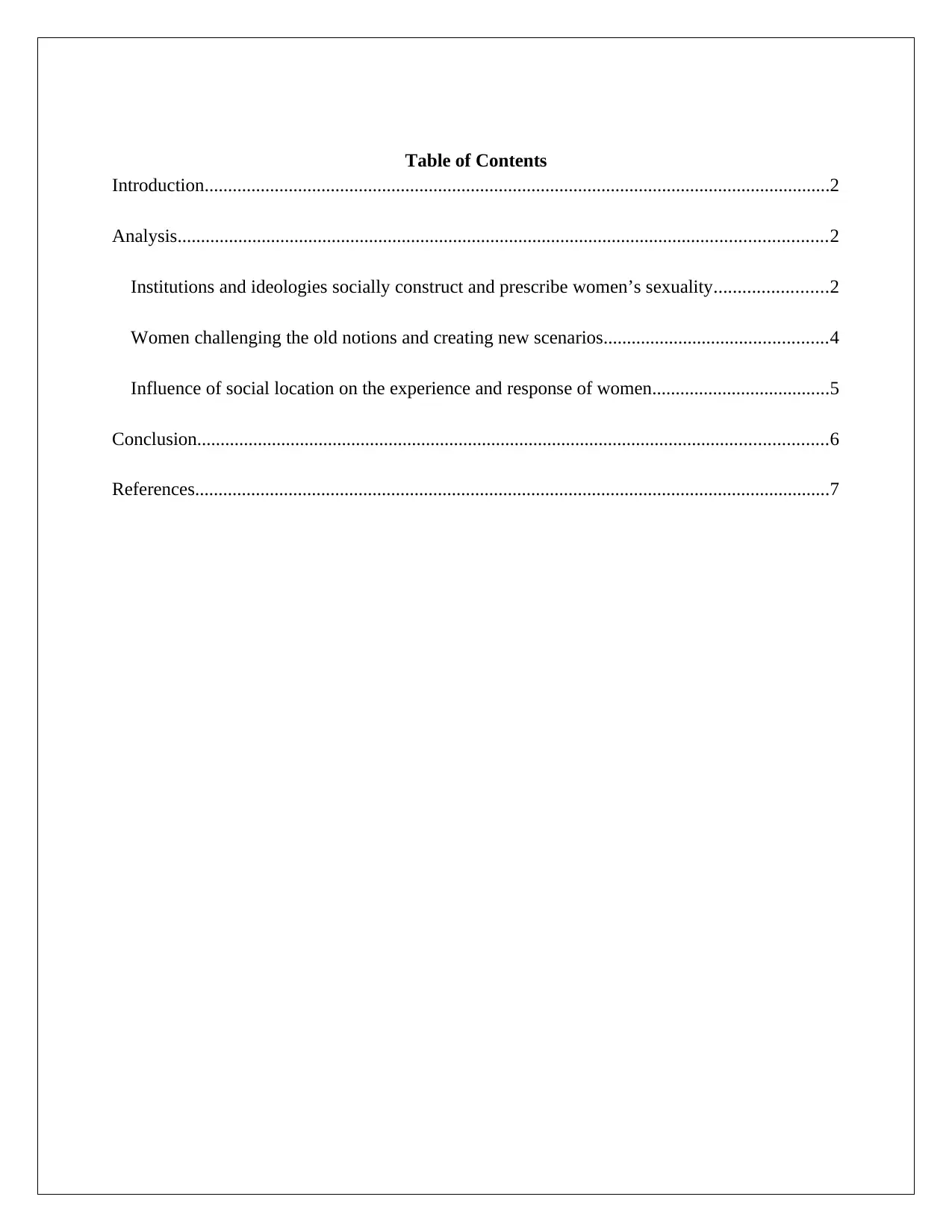
Table of Contents
Introduction......................................................................................................................................2
Analysis...........................................................................................................................................2
Institutions and ideologies socially construct and prescribe women’s sexuality........................2
Women challenging the old notions and creating new scenarios................................................4
Influence of social location on the experience and response of women......................................5
Conclusion.......................................................................................................................................6
References........................................................................................................................................7
Introduction......................................................................................................................................2
Analysis...........................................................................................................................................2
Institutions and ideologies socially construct and prescribe women’s sexuality........................2
Women challenging the old notions and creating new scenarios................................................4
Influence of social location on the experience and response of women......................................5
Conclusion.......................................................................................................................................6
References........................................................................................................................................7
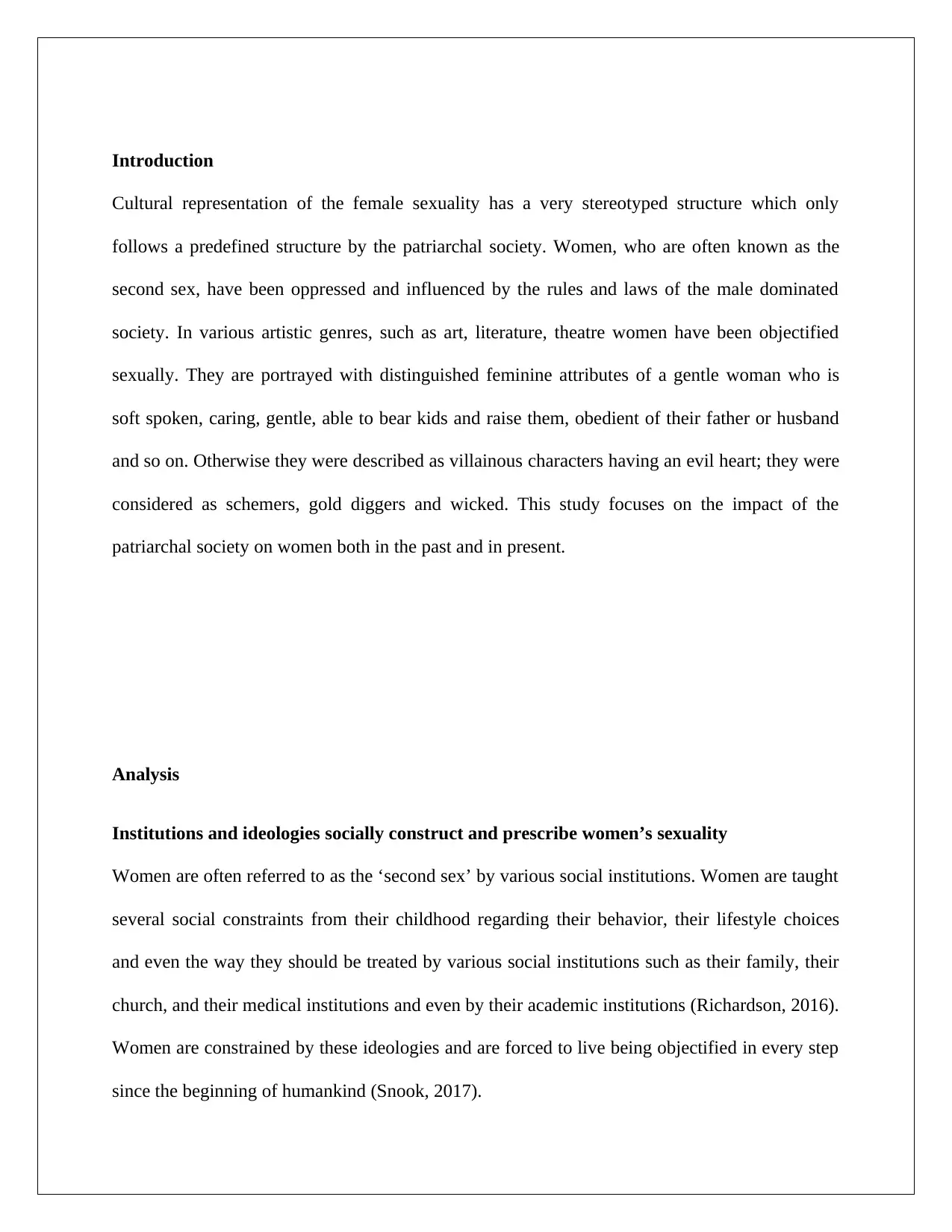
Introduction
Cultural representation of the female sexuality has a very stereotyped structure which only
follows a predefined structure by the patriarchal society. Women, who are often known as the
second sex, have been oppressed and influenced by the rules and laws of the male dominated
society. In various artistic genres, such as art, literature, theatre women have been objectified
sexually. They are portrayed with distinguished feminine attributes of a gentle woman who is
soft spoken, caring, gentle, able to bear kids and raise them, obedient of their father or husband
and so on. Otherwise they were described as villainous characters having an evil heart; they were
considered as schemers, gold diggers and wicked. This study focuses on the impact of the
patriarchal society on women both in the past and in present.
Analysis
Institutions and ideologies socially construct and prescribe women’s sexuality
Women are often referred to as the ‘second sex’ by various social institutions. Women are taught
several social constraints from their childhood regarding their behavior, their lifestyle choices
and even the way they should be treated by various social institutions such as their family, their
church, and their medical institutions and even by their academic institutions (Richardson, 2016).
Women are constrained by these ideologies and are forced to live being objectified in every step
since the beginning of humankind (Snook, 2017).
Cultural representation of the female sexuality has a very stereotyped structure which only
follows a predefined structure by the patriarchal society. Women, who are often known as the
second sex, have been oppressed and influenced by the rules and laws of the male dominated
society. In various artistic genres, such as art, literature, theatre women have been objectified
sexually. They are portrayed with distinguished feminine attributes of a gentle woman who is
soft spoken, caring, gentle, able to bear kids and raise them, obedient of their father or husband
and so on. Otherwise they were described as villainous characters having an evil heart; they were
considered as schemers, gold diggers and wicked. This study focuses on the impact of the
patriarchal society on women both in the past and in present.
Analysis
Institutions and ideologies socially construct and prescribe women’s sexuality
Women are often referred to as the ‘second sex’ by various social institutions. Women are taught
several social constraints from their childhood regarding their behavior, their lifestyle choices
and even the way they should be treated by various social institutions such as their family, their
church, and their medical institutions and even by their academic institutions (Richardson, 2016).
Women are constrained by these ideologies and are forced to live being objectified in every step
since the beginning of humankind (Snook, 2017).
⊘ This is a preview!⊘
Do you want full access?
Subscribe today to unlock all pages.

Trusted by 1+ million students worldwide

The idea of women’s sexuality is built up from the early childhood stages. Little girls are often
taught that they should always keep their genitals covered. History shows that women genitalia
were considered a defect and a diseased condition for a long time (Neuman, 2015). According to
the Greek physician Aretaeus, the uterus was referred as the “animal within an animal” and was
supposed to cause illness amongst people (Nochlin, 2018). He also believed that the vagina has
pleasant smells to attract men towards it and cause mass illness. Even today, people consider the
vagina and the other reproductive organs as a taboo (Modleski, 2014).
In case of art, the body of a woman has also remained a place for fantasy and eroticism. Both
male nudes and women nudes are used in paintings but when the use of the nudes is compared,
there is a stark difference. The painting of a female nude body defines sexuality, degradation and
Mother Nature whereas; the male nude is associated with a sense of power and fulfillment (St
Jean & Feagin, 2015). Another impact of the nude artworks on the society is that, they have
provided a pre-defined standard of beauty, which has pushed the women into criticism based on
their appearance (Hellinger & Motschenbacher, 2015).
taught that they should always keep their genitals covered. History shows that women genitalia
were considered a defect and a diseased condition for a long time (Neuman, 2015). According to
the Greek physician Aretaeus, the uterus was referred as the “animal within an animal” and was
supposed to cause illness amongst people (Nochlin, 2018). He also believed that the vagina has
pleasant smells to attract men towards it and cause mass illness. Even today, people consider the
vagina and the other reproductive organs as a taboo (Modleski, 2014).
In case of art, the body of a woman has also remained a place for fantasy and eroticism. Both
male nudes and women nudes are used in paintings but when the use of the nudes is compared,
there is a stark difference. The painting of a female nude body defines sexuality, degradation and
Mother Nature whereas; the male nude is associated with a sense of power and fulfillment (St
Jean & Feagin, 2015). Another impact of the nude artworks on the society is that, they have
provided a pre-defined standard of beauty, which has pushed the women into criticism based on
their appearance (Hellinger & Motschenbacher, 2015).
Paraphrase This Document
Need a fresh take? Get an instant paraphrase of this document with our AI Paraphraser
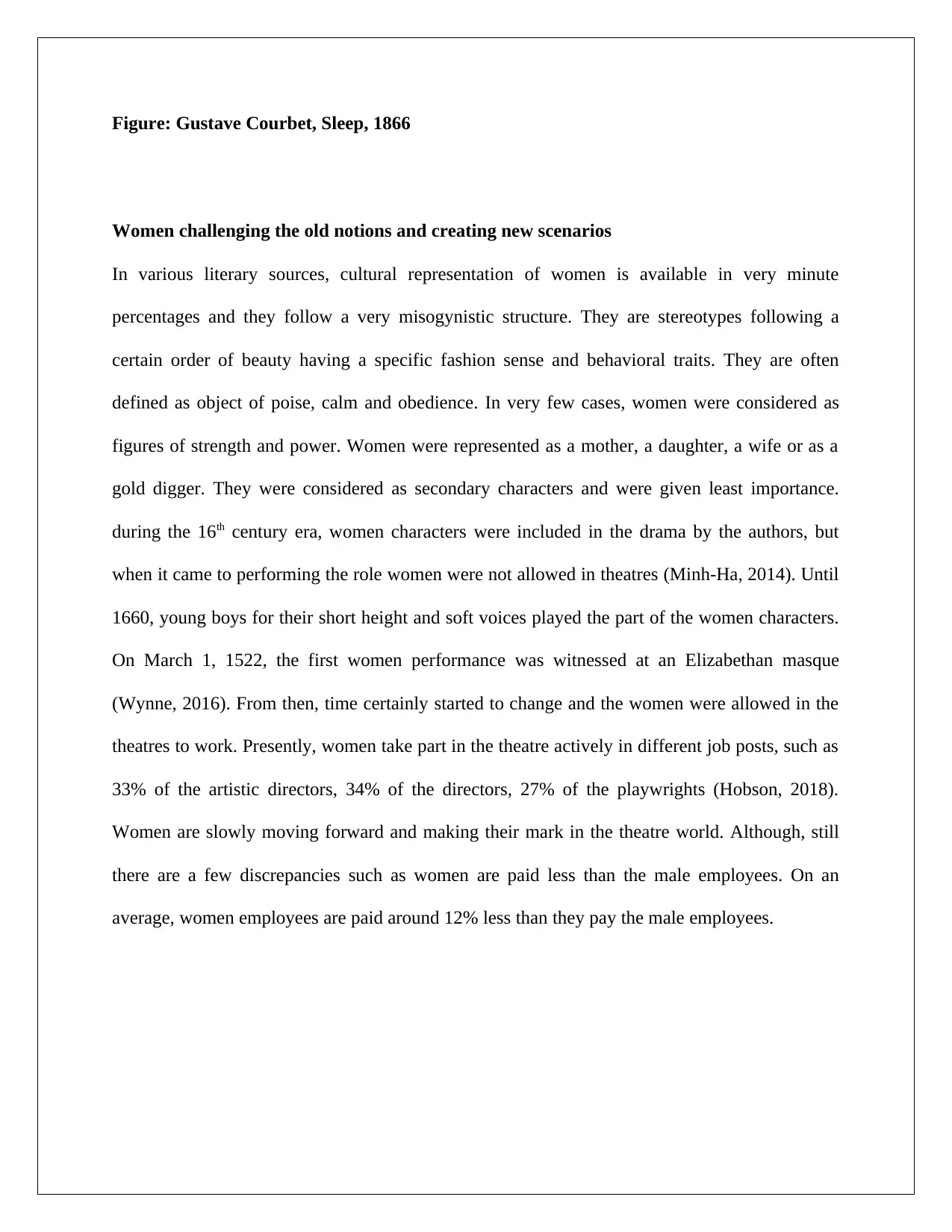
Figure: Gustave Courbet, Sleep, 1866
Women challenging the old notions and creating new scenarios
In various literary sources, cultural representation of women is available in very minute
percentages and they follow a very misogynistic structure. They are stereotypes following a
certain order of beauty having a specific fashion sense and behavioral traits. They are often
defined as object of poise, calm and obedience. In very few cases, women were considered as
figures of strength and power. Women were represented as a mother, a daughter, a wife or as a
gold digger. They were considered as secondary characters and were given least importance.
during the 16th century era, women characters were included in the drama by the authors, but
when it came to performing the role women were not allowed in theatres (Minh-Ha, 2014). Until
1660, young boys for their short height and soft voices played the part of the women characters.
On March 1, 1522, the first women performance was witnessed at an Elizabethan masque
(Wynne, 2016). From then, time certainly started to change and the women were allowed in the
theatres to work. Presently, women take part in the theatre actively in different job posts, such as
33% of the artistic directors, 34% of the directors, 27% of the playwrights (Hobson, 2018).
Women are slowly moving forward and making their mark in the theatre world. Although, still
there are a few discrepancies such as women are paid less than the male employees. On an
average, women employees are paid around 12% less than they pay the male employees.
Women challenging the old notions and creating new scenarios
In various literary sources, cultural representation of women is available in very minute
percentages and they follow a very misogynistic structure. They are stereotypes following a
certain order of beauty having a specific fashion sense and behavioral traits. They are often
defined as object of poise, calm and obedience. In very few cases, women were considered as
figures of strength and power. Women were represented as a mother, a daughter, a wife or as a
gold digger. They were considered as secondary characters and were given least importance.
during the 16th century era, women characters were included in the drama by the authors, but
when it came to performing the role women were not allowed in theatres (Minh-Ha, 2014). Until
1660, young boys for their short height and soft voices played the part of the women characters.
On March 1, 1522, the first women performance was witnessed at an Elizabethan masque
(Wynne, 2016). From then, time certainly started to change and the women were allowed in the
theatres to work. Presently, women take part in the theatre actively in different job posts, such as
33% of the artistic directors, 34% of the directors, 27% of the playwrights (Hobson, 2018).
Women are slowly moving forward and making their mark in the theatre world. Although, still
there are a few discrepancies such as women are paid less than the male employees. On an
average, women employees are paid around 12% less than they pay the male employees.

Figure: the comparison between the male employees and women employees in theatre
Influence of social location on the experience and response of women
Women belonging to different classes of the society have to face different kinds of obstacles
such as different gender roles, race issues, issues regarding their sexual orientation and so on. the
difference in gender roles defines the concept of behaviors women are expected to follow.
According to Canadian culture, the women are expected to be caring creatures (Shevelow, 2015).
Even the new born babies have to carry on this culture such as pink dresses for the girl and blue
dresses for the boy. The present era is all about breaking the barriers and the stereotypes, so now
women educate themselves and support themselves financially without depending on any man.
Even if they choose to have a family, they are managing their family and their job together.
Women have fought for ages and slowly they have started to get the results. In many countries of
the world now, women are allowed to follow their own sexual orientation even if it is different
Influence of social location on the experience and response of women
Women belonging to different classes of the society have to face different kinds of obstacles
such as different gender roles, race issues, issues regarding their sexual orientation and so on. the
difference in gender roles defines the concept of behaviors women are expected to follow.
According to Canadian culture, the women are expected to be caring creatures (Shevelow, 2015).
Even the new born babies have to carry on this culture such as pink dresses for the girl and blue
dresses for the boy. The present era is all about breaking the barriers and the stereotypes, so now
women educate themselves and support themselves financially without depending on any man.
Even if they choose to have a family, they are managing their family and their job together.
Women have fought for ages and slowly they have started to get the results. In many countries of
the world now, women are allowed to follow their own sexual orientation even if it is different
⊘ This is a preview!⊘
Do you want full access?
Subscribe today to unlock all pages.

Trusted by 1+ million students worldwide
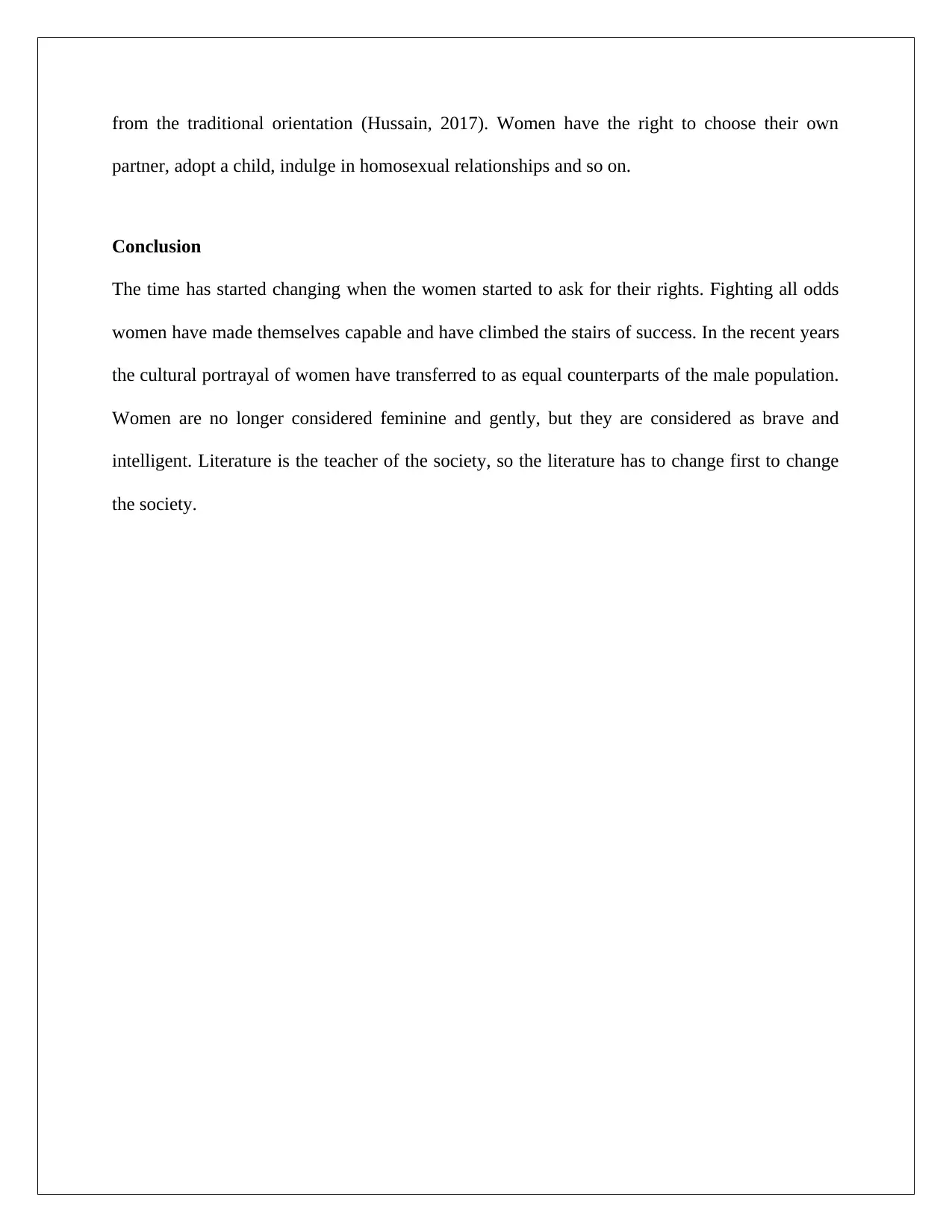
from the traditional orientation (Hussain, 2017). Women have the right to choose their own
partner, adopt a child, indulge in homosexual relationships and so on.
Conclusion
The time has started changing when the women started to ask for their rights. Fighting all odds
women have made themselves capable and have climbed the stairs of success. In the recent years
the cultural portrayal of women have transferred to as equal counterparts of the male population.
Women are no longer considered feminine and gently, but they are considered as brave and
intelligent. Literature is the teacher of the society, so the literature has to change first to change
the society.
partner, adopt a child, indulge in homosexual relationships and so on.
Conclusion
The time has started changing when the women started to ask for their rights. Fighting all odds
women have made themselves capable and have climbed the stairs of success. In the recent years
the cultural portrayal of women have transferred to as equal counterparts of the male population.
Women are no longer considered feminine and gently, but they are considered as brave and
intelligent. Literature is the teacher of the society, so the literature has to change first to change
the society.
Paraphrase This Document
Need a fresh take? Get an instant paraphrase of this document with our AI Paraphraser
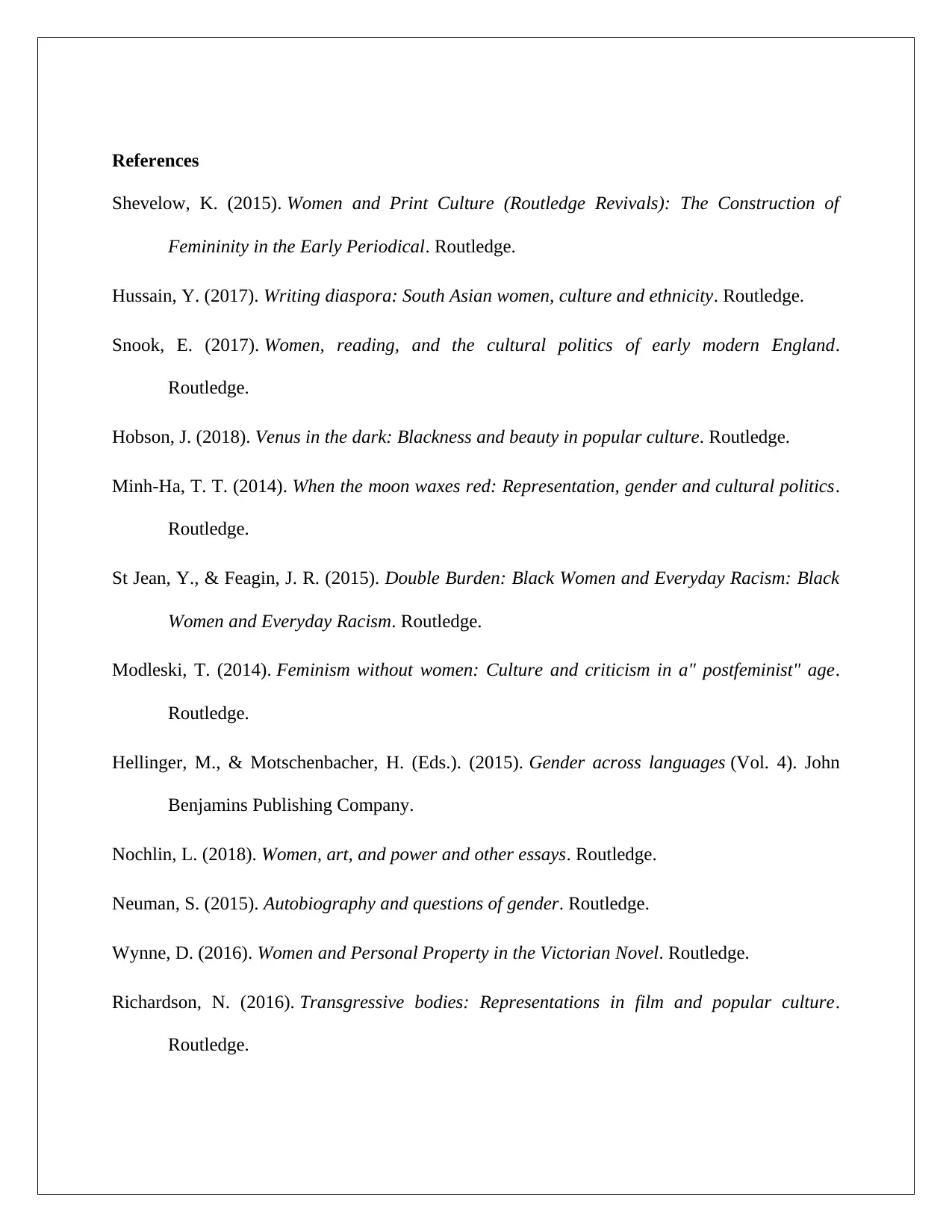
References
Shevelow, K. (2015). Women and Print Culture (Routledge Revivals): The Construction of
Femininity in the Early Periodical. Routledge.
Hussain, Y. (2017). Writing diaspora: South Asian women, culture and ethnicity. Routledge.
Snook, E. (2017). Women, reading, and the cultural politics of early modern England.
Routledge.
Hobson, J. (2018). Venus in the dark: Blackness and beauty in popular culture. Routledge.
Minh-Ha, T. T. (2014). When the moon waxes red: Representation, gender and cultural politics.
Routledge.
St Jean, Y., & Feagin, J. R. (2015). Double Burden: Black Women and Everyday Racism: Black
Women and Everyday Racism. Routledge.
Modleski, T. (2014). Feminism without women: Culture and criticism in a" postfeminist" age.
Routledge.
Hellinger, M., & Motschenbacher, H. (Eds.). (2015). Gender across languages (Vol. 4). John
Benjamins Publishing Company.
Nochlin, L. (2018). Women, art, and power and other essays. Routledge.
Neuman, S. (2015). Autobiography and questions of gender. Routledge.
Wynne, D. (2016). Women and Personal Property in the Victorian Novel. Routledge.
Richardson, N. (2016). Transgressive bodies: Representations in film and popular culture.
Routledge.
Shevelow, K. (2015). Women and Print Culture (Routledge Revivals): The Construction of
Femininity in the Early Periodical. Routledge.
Hussain, Y. (2017). Writing diaspora: South Asian women, culture and ethnicity. Routledge.
Snook, E. (2017). Women, reading, and the cultural politics of early modern England.
Routledge.
Hobson, J. (2018). Venus in the dark: Blackness and beauty in popular culture. Routledge.
Minh-Ha, T. T. (2014). When the moon waxes red: Representation, gender and cultural politics.
Routledge.
St Jean, Y., & Feagin, J. R. (2015). Double Burden: Black Women and Everyday Racism: Black
Women and Everyday Racism. Routledge.
Modleski, T. (2014). Feminism without women: Culture and criticism in a" postfeminist" age.
Routledge.
Hellinger, M., & Motschenbacher, H. (Eds.). (2015). Gender across languages (Vol. 4). John
Benjamins Publishing Company.
Nochlin, L. (2018). Women, art, and power and other essays. Routledge.
Neuman, S. (2015). Autobiography and questions of gender. Routledge.
Wynne, D. (2016). Women and Personal Property in the Victorian Novel. Routledge.
Richardson, N. (2016). Transgressive bodies: Representations in film and popular culture.
Routledge.
1 out of 8
Related Documents
Your All-in-One AI-Powered Toolkit for Academic Success.
+13062052269
info@desklib.com
Available 24*7 on WhatsApp / Email
![[object Object]](/_next/static/media/star-bottom.7253800d.svg)
Unlock your academic potential
Copyright © 2020–2025 A2Z Services. All Rights Reserved. Developed and managed by ZUCOL.




